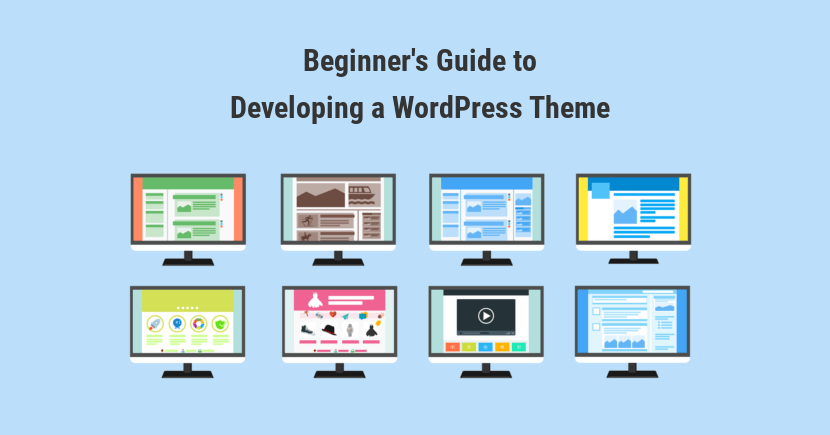Beginner’s Guide to Developing a WordPress Theme
This article will guide to developing a wordpress theme. You know what is common between HTML, CSS, JavaScript and WordPress? The first three have potential to make beautiful websites and WordPress how can there be anything common between these four? Well, all of them have succeeded in overcoming the misconception that traditionally belies it.
Blogging platforms have come and gone, but WordPress is surely an exception! Since its release in 2003, the Content Management System is considered as one of the most dominant CMS on the market. Here’s a bunch of some shocking stats regarding WordPress development that might help put it all into perspective.
Guide to Developing a WordPress Theme
- According to W3techs, WordPress has 61.8% of the CMS market share — more than all other systems (eg, Drupal, Joomla) combined.
- Among 1.3 billion active websites, 455,000,000 websites are using WordPress right now
- Local communities organize WordCamps for users of all skill levels. And it’s all so good so far around 1,063 WordCamps, in 76 cities across the globe.
We must all face the choice, between what is right and what is easy. And in today’s fast pacing life choosing what is easy becomes a compulsion, like it or not! Speaking of which, WordPress users often tend to pick a ready-made theme but why don’t you consider creating one of your own. After all, it can definitely provide an undeniable advantage. Like a river, WordPress is in a constant state of motion. Even at some point, you feel there is no room for improvement; boom! The new thing you get to know is you have to deal with upcoming updates, versions and the pressure to adopt it.
With the dawn of today, to create a brand new custom theme all by yourself. So, that it is done right- the way you want!
WordPress Theme Development
We all tend to aim for the best, we try every trick in the book to have a site look great featuring all crucial functionality. And here compromising is not an option. So, that’s it all you require doing is start creating your own theme. For this, you can surely seek help from a relevant WordPress development company that offers a cookie-cutter solution for your needs or simply just do it!

Option #1 Create a starter theme
It progressively sorts of a no-frills WordPress theme which can be used as a base for creating your own. which can be utilized as a base for making your own. Utilizing such sort of topic empowers you to expand on a strong system, without agonizing over the complexities engaged with coding a topic without any preparation. It will likewise assist you with seeing how WordPress functions by demonstrating you the essential structure of a topic and how the entirety of its parts cooperate.
We are sufficiently blessed to be in a space where one can experience superb starter subjects including Underscores, UnderStrap, and Bones. Also, this starter subject is created via Automattic, which makes it bound to be protected, perfect, and very much bolstered over the long haul.
Option #2 Modify an Existing Theme
According to WordPress developers, this one should be the easiest option available around especially when you wish to make any minor changes such as colors, font sizes, or simple layout changes.
So what can be done is to create a child theme. A child theme references an existing theme, just modifying the bits you want to change. Using a child theme has the advantage that, if the parent theme is updated when you update WordPress, your changes won’t be wiped away.
Create a new folder inside your /themes/ folder. Here try using the name of the parent theme with -child appended, as this makes it clear what the child theme is. So in case, if you are creating a child theme of the Twenty Seventeen theme, your child theme folder might be called /twentyseventeen-child/. And now it’s time to get your child theme up and running!
Option 3: Adapt an existing theme
Are you keen enough to dig into WordPress code a bit more? Why don’t you duplicate an existing theme and bend it according to your needs? This might involve things like deleting all of the current styles and creating your own. More importantly, you can also think of involving things like deleting all of the current styles and creating your own.
Also, get into the nitty-gritty of other theme files and remove elements you don’t need and add others.
Option 4: Build a Theme from Scratch
The most daunting of all but that surely doesn’t mean it won’t be fun anymore! In fact, it is way simpler than it sounds because all you need is style.css and index.php. This would result in a pretty limited theme, I mean you might get a functions.php file for custom functions, and perhaps several other template files for the various sections of the site, such as a 404.php template file for showing 404 pages.
But first, you need to add some header text:
/*
Theme Name: My Scratch Theme
Theme URI: https://www.etatvasoft.com/
Author: Olivia Diaz
Author URI: https://www.etatvasoft.com/
Description: Just a fancy starter theme for eTatvaSoft
Version: 1
License: GNU General Public License v2 or later
License URI: http://www.gnu.org/licenses/gpl-2.0.html
Tags: clean, starter
*/And now, all you need to do is head to the WordPress admin Themes section where you will find your Customer WordPress theme listed.
Adding Posts
Now if you have already drafted posts before have you wondered how would you display them into your custom-made theme? By using a special type of PHP function known as the Loop. The Loop is just a specialized piece of code that displays your posts and comments wherever you place it.
To display your posts in the content section of the index.php template, copy and paste the following code between the <div class="content"> and </div> tags as shown below:
<div class="content">
<?php if ( have_posts() ) : ?>
<?php while ( have_posts() ) : the_post(); ?>
<div id="post-<?php the_ID(); ?>" <?php post_class(); ?>>
<div class="post-header">
<div class="date"><?php the_time( 'M j y' ); ?></div>
<h2><a href="<?php the_permalink(); ?>" rel="bookmark" title="Permanent Link to <?php the_title_attribute(); ?>"><?php the_title(); ?></a></h2>
<div class="author"><?php the_author(); ?></div>
</div><!-- .post-header -->
<div class="entry clear">
<?php if ( function_exists( 'add_theme_support' ) ) the_post_thumbnail(); ?>
<?php the_content(); ?>
<?php edit_post_link(); ?>
<?php wp_link_pages(); ?>
</div><!-- .entry -->
<footer class="post-footer">
<div class="comments"><?php comments_popup_link( 'Leave a Comment', '1 Comment', '% Comments' ); ?></div>
</footer><!-- .post-footer -->
</div><!-- .post -->
<?php endwhile; /* rewind or continue if all posts have been fetched */ ?>
<nav class="navigation index">
<div class="alignleft"><?php next_posts_link( 'Older Entries' ); ?></div>
<div class="alignright"><?php previous_posts_link( 'Newer Entries' ); ?></div>
</nav><!-- .navigation -->
<?php else : ?>
<?php endif; ?>
</div><!-- .content -->That will take care of your posts. Easy as ABC. At this juncture (and using the sample files provided in this tutorial), your header.php should look like this:
<head>
<meta charset="<?php bloginfo( 'charset' ); ?>">
<meta name="viewport" content="width=device-width">
<title><?php wp_title( '|', true, 'right' ); ?></title>
<link rel="profile" href="http://gmpg.org/xfn/11">
<link rel="pingback" href="<?php bloginfo( 'pingback_url' ); ?>">
<!--[if lt IE 9]>
<script src="<?php echo get_template_directory_uri(); ?>/js/html5.js"></script>
<![endif]-->
<?php wp_head(); ?>
</head>And your sidebar.php should look like this:
<?php dynamic_sidebar( 'sidebar' ); ?>Whereas your footer.php should look like this:
<footer class="footer">
<p>And this is the footer</p>
</footer>
<?php wp_footer(); // Crucial core hook! ?>
</body>
</html>That was easy, right? You can style your theme however you want. Thats all you need guide to developing a wordpress theme.
Final Thoughts
I hope you enjoyed reading this post guide to developing a wordpress theme, I was unable to think about a progressively fun approach to dive into a WordPress subject, figure out how it works and tailor it to your accurate necessities, without rehashing an already solved problem and start without any preparation.
We hope you have found this article helpful. Let us know your questions or feedback if any through the comment section in below. You can subscribe our newsletter and get notified when we publish new WordPress articles for free. Moreover, you can explore here other WordPress related articles.
If you like our article, please consider buying a coffee for us.
Thanks for your support!
 Buy me a coffee!
Buy me a coffee!


Join the Discussion.